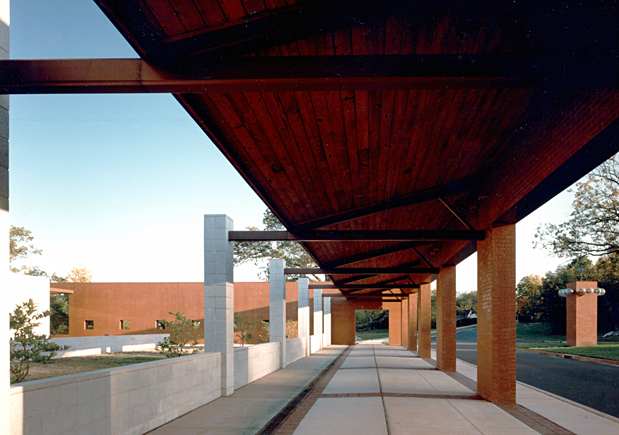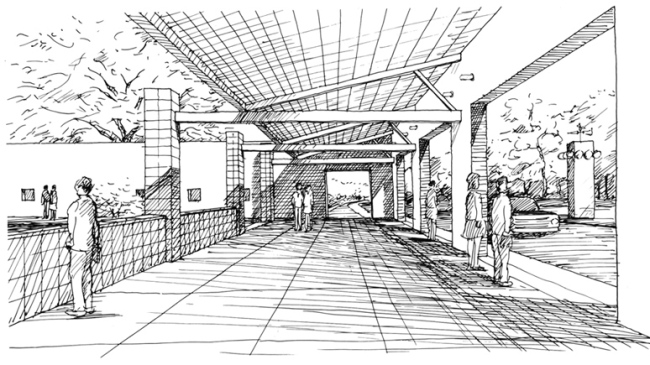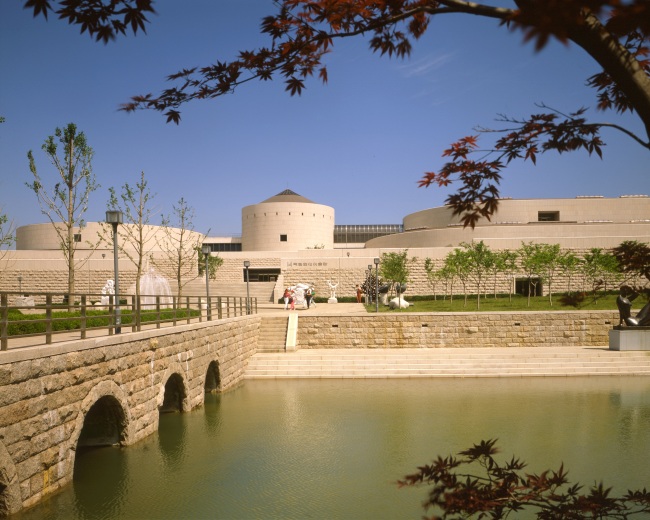뉴스속보 상세보기
A cluster of traditional thatched roof houses on a hill helped architect Kim Tai-soo make progress in the early days of his architectural career in the United States.
These houses were located in the rural town of Haman-gun, South Gyeongsang Province, which had been a sanctuary for Kim and his family during the Korean War.
“It’s a small town where my family fled to avoid bombings in Seoul during the Korean War. We stayed there for a year,” he said. “The scene of the houses gathered on a hill was very beautiful.”
In the early 1960s, Kim left Korea for Yale University’s prestigious school of architecture. According to Kim, Korea did not have a strong foundation in architecture back then as the country was struggling to recover from the 1950s Korean War.
He flew to the U.S., hoping to find some direction in his field, pursuing his second master’s degree in architecture at Yale even though he had already earned one at Seoul National University in 1960.
In the United States, he struggled to overcome culture shock and difficulties in communicating in English. One of the biggest challenges was presentations in which he had to explain his design projects based on Western theories and philosophies.
Referring to Western philosophers, such as German philosopher Nietzsche, was one way architecture students supported their design ideas.
“I couldn’t cite those ideas. I thought it didn’t make sense for me to refer to such ideas by Nietzsche or someone else,” said Kim, at the press preview of his retrospective at the Gwacheon branch of the National Museum of Modern and Contemporary Art, Korea, last week.
“I asked myself – what do I have?”
At the time, he recalled an image that had lingered with him for a long time – the cluster of thatched roof houses in the rural town of Haman-gun. He visualized this image in his design projects at school and during his years as an architect in the U.S. and Korea.
“Western architecture is object-based, focusing on buildings as works of art. But I envisioned my architecture to have a balanced view with the surroundings just like the thatched roof houses on the hill,” he said.
Kim also realized during his studies at Yale that it would not be easy for him to design buildings that are as sculptural and monumental such as those made by celebrated French architect Le Corbusier.
“It is important to discover what you can do, but it is also equally important to find out what you are not capable of. It would have been a waste of time if I were to emulate designs of others,” Kim said.
He decided to turn to the basic element of architecture – the rectangle box structure – while keeping in mind the “beauty in the repeated formation” of the hilltop thatched roof houses.
“I was confident that I could make good architecture based on simple, fundamental architectural elements,” said Kim.
The basic rectangle structure and its repeated variations appear in his early works. Most of them are private residences in the U.S., including his own in Hartford, Connecticut. The designs were simple, yet practical, each reflecting the different needs and lifestyles of its residents.
“Designing houses was the process through which I discovered what I am good at,” said Kim, during the exhibition tour.
He became known in the U.S. architecture world for his simplicity and practicality and was sought to design public buildings.
His major creations in the U.S. include the award-winning Middlebury Elementary School, the submarine training facility of the U.S. Navy, Groton Senior Center, the University of Hartford Gray Center, the U.S. Embassy in Tunisia whose sketches, layouts and miniature models are on display at his retrospective. He received the prestigious American Institute of Architects’ 1985 Honor Award for his design of Middlebury Elementary School in 1982.
His success in the U.S. brought him back to Korea in the 1980s when he was commissioned to design buildings for big corporations such as Kyobo Life Insurance and LG.
In 1983, the Korean government asked him to design the country’s first and biggest modern art museum, the Gwacheon branch of the National Museum of Modern and Contemporary Art.
Inspired by the Cheonggyesan Mountain that surrounds the museum site, he designed a structure that sits in balance with the surrounding terrain. He said he thought of old Buddhist temples in Korea that sit in harmony with the surrounding mountains.
To create harmony, he used granite stones that were found in Cheonggyesan Mountain as the main construction material.
“I decided to use pink granite that was the most common material in Korea, not the popular marble imported from Italy that was preferred by Koreans in the 1980s,” he said.
The museum’s exterior and interior walls are in pink granite stones, which Kim used to give unity to the complex shape of the museum building.
“I believe the building should be part of the land,” he said.
“Tai Soo Kim Retrospective: Working in Two Worlds” runs until June 6 at the Gwacheon museum of the MMCA. For more information, visit www.mmca.go.kr.
By Lee Woo-young (wylee@heraldcorp.com)
These houses were located in the rural town of Haman-gun, South Gyeongsang Province, which had been a sanctuary for Kim and his family during the Korean War.
“It’s a small town where my family fled to avoid bombings in Seoul during the Korean War. We stayed there for a year,” he said. “The scene of the houses gathered on a hill was very beautiful.”
In the early 1960s, Kim left Korea for Yale University’s prestigious school of architecture. According to Kim, Korea did not have a strong foundation in architecture back then as the country was struggling to recover from the 1950s Korean War.
 |
| Architect Kim Tai-soo (MMCA) |
He flew to the U.S., hoping to find some direction in his field, pursuing his second master’s degree in architecture at Yale even though he had already earned one at Seoul National University in 1960.
In the United States, he struggled to overcome culture shock and difficulties in communicating in English. One of the biggest challenges was presentations in which he had to explain his design projects based on Western theories and philosophies.
Referring to Western philosophers, such as German philosopher Nietzsche, was one way architecture students supported their design ideas.
“I couldn’t cite those ideas. I thought it didn’t make sense for me to refer to such ideas by Nietzsche or someone else,” said Kim, at the press preview of his retrospective at the Gwacheon branch of the National Museum of Modern and Contemporary Art, Korea, last week.
“I asked myself – what do I have?”
At the time, he recalled an image that had lingered with him for a long time – the cluster of thatched roof houses in the rural town of Haman-gun. He visualized this image in his design projects at school and during his years as an architect in the U.S. and Korea.
 |
| U.S. Embassy in Tunisia (MMCA) |
“Western architecture is object-based, focusing on buildings as works of art. But I envisioned my architecture to have a balanced view with the surroundings just like the thatched roof houses on the hill,” he said.
Kim also realized during his studies at Yale that it would not be easy for him to design buildings that are as sculptural and monumental such as those made by celebrated French architect Le Corbusier.
“It is important to discover what you can do, but it is also equally important to find out what you are not capable of. It would have been a waste of time if I were to emulate designs of others,” Kim said.
He decided to turn to the basic element of architecture – the rectangle box structure – while keeping in mind the “beauty in the repeated formation” of the hilltop thatched roof houses.
“I was confident that I could make good architecture based on simple, fundamental architectural elements,” said Kim.
The basic rectangle structure and its repeated variations appear in his early works. Most of them are private residences in the U.S., including his own in Hartford, Connecticut. The designs were simple, yet practical, each reflecting the different needs and lifestyles of its residents.
“Designing houses was the process through which I discovered what I am good at,” said Kim, during the exhibition tour.
He became known in the U.S. architecture world for his simplicity and practicality and was sought to design public buildings.
 |
| Middlebury Elementary School in Indiana (Tai Soo Kim Partners) |
 |
| A sketch by Kim Tai-soo for the Middlebury Elementary School in Indiana (Tai Soo Kim Partners) |
His major creations in the U.S. include the award-winning Middlebury Elementary School, the submarine training facility of the U.S. Navy, Groton Senior Center, the University of Hartford Gray Center, the U.S. Embassy in Tunisia whose sketches, layouts and miniature models are on display at his retrospective. He received the prestigious American Institute of Architects’ 1985 Honor Award for his design of Middlebury Elementary School in 1982.
His success in the U.S. brought him back to Korea in the 1980s when he was commissioned to design buildings for big corporations such as Kyobo Life Insurance and LG.
In 1983, the Korean government asked him to design the country’s first and biggest modern art museum, the Gwacheon branch of the National Museum of Modern and Contemporary Art.
Inspired by the Cheonggyesan Mountain that surrounds the museum site, he designed a structure that sits in balance with the surrounding terrain. He said he thought of old Buddhist temples in Korea that sit in harmony with the surrounding mountains.
To create harmony, he used granite stones that were found in Cheonggyesan Mountain as the main construction material.
 |
| Gwacheon Museum of the National Modern and Contemporary Art, Korea (MMCA) |
“I decided to use pink granite that was the most common material in Korea, not the popular marble imported from Italy that was preferred by Koreans in the 1980s,” he said.
The museum’s exterior and interior walls are in pink granite stones, which Kim used to give unity to the complex shape of the museum building.
“I believe the building should be part of the land,” he said.
“Tai Soo Kim Retrospective: Working in Two Worlds” runs until June 6 at the Gwacheon museum of the MMCA. For more information, visit www.mmca.go.kr.
By Lee Woo-young (wylee@heraldcorp.com)


